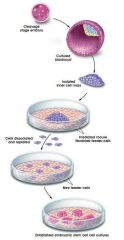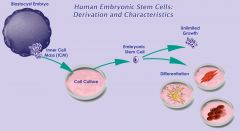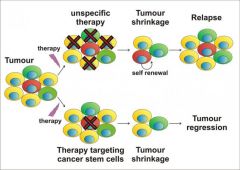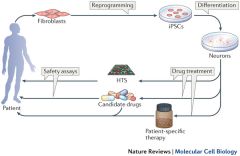![]()
![]()
![]()
Use LEFT and RIGHT arrow keys to navigate between flashcards;
Use UP and DOWN arrow keys to flip the card;
H to show hint;
A reads text to speech;
37 Cards in this Set
- Front
- Back
|
What are stem cells? |
Non – specialised Cells |
|
|
What is the fertlilised egg? |
Totipotent Can make all extra-embryonic tissue, the embryoitself, all the tissues and organs of the body |
|
|
What is the Pluripotent ---> Blastocyst ---> Embryonic stem cells? |
Gives rise tissue stem cells for all three germ layers:endoderm, mesoderm, and ectoderm |
|
|
What are the multipotent Tissue stem cells? |
Give rise to cell types of a specific tissue ----> adult stem cells Hematopoetic SCs Neural SCs Mesenchymal SCs |
|
|
What are the Cell types ofa specifictissue? |
Blood cells Cells of the nervous system Connective tissue, boneCartilage, fat etc |
|
|
Why are we interested in stem cells? |
• Understand early human development (infertility, birth defects) • Understand control of cell division (cancer) • Cell-based therapies • Reduce need for organ and tissue donors/transplants • Replace mutant or damaged cells for treatment of diseases such asParkinson’s disease, spinal cord injury, muscular dystrophy, heartdisease, liver dysfunction, osteoporosis, vision and hearing loss • Cell based drug screening platform |
|
|
ES cells - Where do ES cells come from? |
Human ES cells are derived from donated excess IVF embryos. Blastocysts |
|
|
What are ES cells - in the laboratory? |
• Can be grown indefinitely inthe laboratory. • Have potential to generate allcell types in our body(pluripotent). • differentiation can becontrolled/manipulated inculture to generate specificcell types. |
|
|
What do feeders provide? |
Feeders provide factors that maintain ES cell growth |
|
|
What happens to the day 13 mouse embryos in the lab? |
Day 13 mouse embryos ----> Remove heads and internalorgans -----> Treat with trypsin and plate cells intoa dish ----> MEFs: mouse embryonic fibroblasts. Irradiated to stop growth |
|
|
How do we Ensure cultured cells are stem cells - 1? |

inspect cells througha microscope to seeif look healthy andundifferentiated |
|
|
What does this ensure? |
Ensures cells arecapable oflong-term self-renewal |
|
|
What happens in Ensuring cultured cells are stem cells - 2? |

|
|
|
How are the stem cells differentiated? |
Subculture inlineage-specificdifferentiation conditions |
|
|
What does spontaneous differentiation lead to? |
Spontaneousdifferentiationinto cell of threegerm layers |
|
|
What does aggregation form? |
Aggregation to formEmbryoid body |
|
|
What is Karyotyping? |
Karyotype is a test to identify and evaluate the size, shape, and number of chromosomes in a sample of body cells. Extra or missing chromosomes, or abnormal positions of chromosome pieces, can cause problems with a person's growth, development, and body functions |
|
|
What are pluripotent Oct4, NANOG, SOX2? |
OCT4, NANOG, and SOX2are three basic transcription factors |
|
|
What are the ES cells: Challenges? |
Defining conditions for differentiation |
|
|
What do ES cells give rise to? |
ES cells can give rise to all tissues |
|
|
What is the Controversy over embryonic stem cells? |
• Embryonic stem cells are derived from extra blastocystsgenerated during fertility treatment • Extracting embryonic stem cells destroys the developingBlastocyst Questions for consideration • Is it morally acceptable to use embryos for research? • Is an embryo a person? • When do we become human being? |
|
|
What are tissue stem cells? |
• Generate tissues of the body during development • Includes stem cells isolated from fetal and cord blood • Retained in adult tissues where they are involved in repair and replacement |
|
|
What are Haematopoietic stem cells (HSCs)? |
Hematopoietic stem cells (HSCs) or hemocytoblasts are the stem cells that give rise to all the other blood cells through the process of haematopoiesis. They are derived from mesoderm and located in the red bone marrow, which is contained in the core of most bones |
|
|
What is a progenitor cell? |
A progenitor cell is a biological cell that, like a stem cell, has a tendency to differentiate into a specific type of cell, but is already more specific than a stem cell and is pushed to differentiate into its "target" cell. |
|
|
What are Mesenchymal stem cells (MSCs)? |
Mesenchymal stem cells, or MSCs, are multipotent stromal cells that can differentiate into a variety of cell types, including: osteoblasts (bone cells), chondrocytes (cartilage cells), myocytes (muscle cells) and adipocytes (fat cells) |
|
|
What are Neural stem cells (NSCs)? |
Neural stem cells (NSCs) are self-renewing, multipotent cells that generate the neurons and glia of the nervous system of all animals during embryonic development. |
|
|
What are the two neurogenic regions in the adult brain? |
Subventricular zone (SVZ) lining the lateral ventricles Sensory informationassociatedwith olfaction (smell) Subgranular zone (SGZ) of the hippocampal dentate gyrus Spacial learningMemorymood |
|
|
What is the Summary of basic stem cell characteristics? |
Stem cell ---> committed progenitors: ----> specialized cells: |
|
|
What is the stem cell niche? |
Microenvironment around stem cells that provides support and signalsregulating self-renewal and differentiation |
|
|
What are Cancer stem cells? |
Cancer stem cells (CSCs) are cancer cells (found within tumors or hematological cancers) that possess characteristics associated with normal stem cells, specifically the ability to give rise to all cell types found in a particular cancer sample. CSCs are therefore tumorigenic (tumor-forming) |
|
|
What is stem cell cancer treatment? |

|
|
|
What is Reproductive cloning and stem cell research? |

Cloned mammals, whose nuclei came from adult somatic cells. Somatic Cell Nuclear Transfer |
|
|
What are the The Yamanaka factors - pluripotent factors? |
OCT4 SOX2 KLF4C - MYC |
|
|
What are Induced pluripotent stem cells? |
• Similar properties to embryonic stemcells • Can create stem cells directly from apatient for research, drug screening • Bypass ethical issues |
|
|
What are iPSCs transduced by? |
Transduce withOCT4, SOX2,KLF4, cMYC |
|
|
What is the iPS: mechanism, transplantation, drug discovery? |

|
|
|
What are the Current applications of iPSCs? |
Treat blood diseases Umbilical cordstem cells ----> Treat burns, Leukaemiain children Limbal stem cells(cornea) ----> Repaircornealdamage Mesenchymalstem cellsIn clinical trials ---> Bone and cartilage repair ---> cardiovascular disease(blood vessel repair) |

